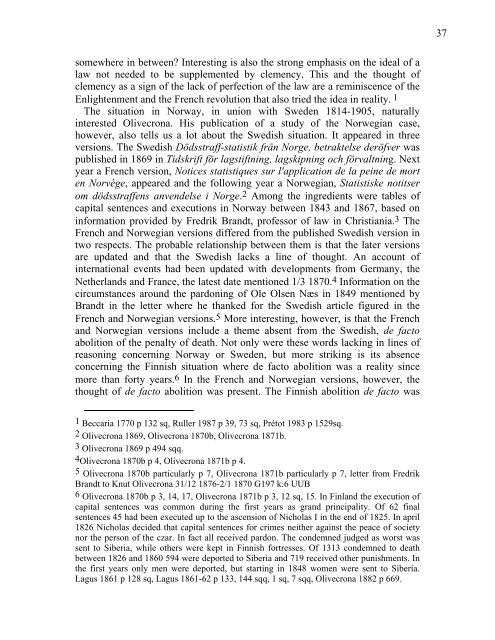Knut Olivecrona and his ”Om dödsstraffet”. - Figuras
Knut Olivecrona and his ”Om dödsstraffet”. - Figuras
Knut Olivecrona and his ”Om dödsstraffet”. - Figuras
You also want an ePaper? Increase the reach of your titles
YUMPU automatically turns print PDFs into web optimized ePapers that Google loves.
somewhere in between? Interesting is also the strong emphasis on the ideal of a<br />
law not needed to be supplemented by clemency. T<strong>his</strong> <strong>and</strong> the thought of<br />
clemency as a sign of the lack of perfection of the law are a reminiscence of the<br />
Enlightenment <strong>and</strong> the French revolution that also tried the idea in reality. 1<br />
The situation in Norway, in union with Sweden 1814-1905, naturally<br />
interested <strong>Olivecrona</strong>. His publication of a study of the Norwegian case,<br />
however, also tells us a lot about the Swedish situation. It appeared in three<br />
versions. The Swedish Dödsstraff-statistik från Norge, betraktelse deröfver was<br />
published in 1869 in Tidskrift för lagstiftning, lagskipning och förvaltning. Next<br />
year a French version, Notices statistiques sur l'application de la peine de mort<br />
en Norvège, appeared <strong>and</strong> the following year a Norwegian, Statistiske notitser<br />
om dödsstraffens anvendelse i Norge.2 Among the ingredients were tables of<br />
capital sentences <strong>and</strong> executions in Norway between 1843 <strong>and</strong> 1867, based on<br />
information provided by Fredrik Br<strong>and</strong>t, professor of law in Christiania.3 The<br />
French <strong>and</strong> Norwegian versions differed from the published Swedish version in<br />
two respects. The probable relationship between them is that the later versions<br />
are updated <strong>and</strong> that the Swedish lacks a line of thought. An account of<br />
international events had been updated with developments from Germany, the<br />
Netherl<strong>and</strong>s <strong>and</strong> France, the latest date mentioned 1/3 1870.4 Information on the<br />
circumstances around the pardoning of Ole Olsen Næs in 1849 mentioned by<br />
Br<strong>and</strong>t in the letter where he thanked for the Swedish article figured in the<br />
French <strong>and</strong> Norwegian versions.5 More interesting, however, is that the French<br />
<strong>and</strong> Norwegian versions include a theme absent from the Swedish, de facto<br />
abolition of the penalty of death. Not only were these words lacking in lines of<br />
reasoning concerning Norway or Sweden, but more striking is its absence<br />
concerning the Finnish situation where de facto abolition was a reality since<br />
more than forty years.6 In the French <strong>and</strong> Norwegian versions, however, the<br />
thought of de facto abolition was present. The Finnish abolition de facto was<br />
1 Beccaria 1770 p 132 sq, Ruller 1987 p 39, 73 sq, Prétot 1983 p 1529sq.<br />
2 <strong>Olivecrona</strong> 1869, <strong>Olivecrona</strong> 1870b, <strong>Olivecrona</strong> 1871b.<br />
3 <strong>Olivecrona</strong> 1869 p 494 sqq.<br />
4<strong>Olivecrona</strong> 1870b p 4, <strong>Olivecrona</strong> 1871b p 4.<br />
5 <strong>Olivecrona</strong> 1870b particularly p 7, <strong>Olivecrona</strong> 1871b particularly p 7, letter from Fredrik<br />
Br<strong>and</strong>t to <strong>Knut</strong> <strong>Olivecrona</strong> 31/12 1876-2/1 1870 G197 k:6 UUB<br />
6 <strong>Olivecrona</strong> 1870b p 3, 14, 17, <strong>Olivecrona</strong> 1871b p 3, 12 sq, 15. In Finl<strong>and</strong> the execution of<br />
capital sentences was common during the first years as gr<strong>and</strong> principality. Of 62 final<br />
sentences 45 had been executed up to the ascension of Nicholas I in the end of 1825. In april<br />
1826 Nicholas decided that capital sentences for crimes neither against the peace of society<br />
nor the person of the czar. In fact all received pardon. The condemned judged as worst was<br />
sent to Siberia, while others were kept in Finnish fortresses. Of 1313 condemned to death<br />
between 1826 <strong>and</strong> 1860 594 were deported to Siberia <strong>and</strong> 719 received other punishments. In<br />
the first years only men were deported, but starting in 1848 women were sent to Siberia.<br />
Lagus 1861 p 128 sq, Lagus 1861-62 p 133, 144 sqq, 1 sq, 7 sqq, <strong>Olivecrona</strong> 1882 p 669.<br />
37






